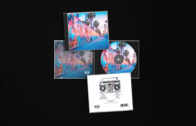Brad Herrera’s Genre-defying Album “This Is What Happened”

Album Review: “This Is What Happened” by Brad Herrera
Written By: Dan Eachus
Brad Herrera has returned with his fourth album, “This Is What Happened,” and it’s a sonic journey that defies categorization. Known primarily for his instrumental electronic music, this album marks a significant departure as it incorporates vocals for the first time. It’s clear that Herrera has taken a bold step forward, allowing himself to explore new creative avenues while tackling a range of serious themes with an unabashed sense of fun and experimentation.
The album opens with the track “Coming Up Again,” setting the tone for what’s to come. A pulsating electronic beat introduces us to Herrera’s distinctive sonic landscape. The haunting, glitched lyrics immediately draw you in, reflecting on childhood memories and the passage of time. Herrera’s distant vocals are a pleasant surprise, revealing a vulnerability and depth that adds a whole new dimension to his music. It’s an intriguing mix of nostalgia and the uncertain present, setting the stage for the album’s thematic exploration.
One of the standout tracks, “90 Seconds To Midnight,” showcases Herrera’s willingness to engage with weighty subjects while maintaining a sense of playfulness. The song takes its title from the famous Doomsday Clock, symbolizing the precarious state of the world. It blends haunting electronic melodies with thought-provoking sounds and glitchy vocals that touch on political turmoil, environmental concerns, and existential anxieties. The contrast between the serious subject matter and the music’s infectious groove is a testament to Herrera’s artistic prowess.
Throughout “This Is What Happened,” Herrera masterfully navigates various musical genres within the electronic realm. The album is an eclectic mix of electronic experimentalism, vocals, and jazz production techniques. Each track feels like a unique sonic experiment, and the artist’s willingness to embrace this variety adds depth to the listening experience.
What stands out most in this album is the vast array of instruments and sounds used to tell the story. Herrera’s sonic palette is rich and diverse, with synths, drum machines, and live instrumentation seamlessly blending together. This dynamic range allows him to paint vivid musical landscapes that transport the listener through different emotional states.
“One More” is a prime example of this versatility. It’s a track that fuses elements of jazz and electronic music, creating a surreal and dreamlike atmosphere. Herrera’s vocals here are ethereal, floating over intricate electronic beats and shimmering synths. The song’s overall production encourage breaking free from societal norms and expectations, and the music perfectly encapsulates the sensation of escaping into a new world of possibilities.
As the album progresses, Herrera continues to surprise with his willingness to take risks. “If I Change It’s For Myself” is a poignant ballad that explores the complexities of dealing with one’s inner self. It’s a stark departure from the electronic beats that dominate most of the album, yet it feels entirely at home in this eclectic collection. Herrera’s emotive yet glitched vocals convey a sense of raw honesty, making this track one of the album’s emotional highlights.
On “This Is What Happened,” Herrera isn’t afraid to embrace absurdity, which is particularly evident in the song “I Hurt You, I Hurt Me Too.” This track combines off-kilter rhythms with surreal , chaoticly explicit lyrics that playfully critique the chaotic state of the world. The result is a captivating blend of humor and contemplation, reminding listeners that sometimes when we hurt others, we hurt ourselves as well.
The album’s closing track, “Peach House,” is a fitting conclusion to this musical journey. It’s a slow-building, atmospheric piece that builds anticipation throughout its duration. As Herrera’s vocals haunt, the song encourages us to embrace uncertainty and find hope in the unknown. It’s a message that resonates in today’s ever-changing world.
In “This Is What Happened,” Brad Herrera has crafted an album that defies easy classification. It’s an audacious exploration of various musical styles, emotions, and existential themes. While it’s clear that he’s having fun with his music, there’s a depth and sincerity that shines through. Herrera’s decision to incorporate vocals for the first time adds a personal touch that draws the listener even deeper into his world.
The album’s title, “This Is What Happened,” is a nod to the unpredictability of life and the artist’s willingness to embrace the unexpected. In doing so, Herrera has created an album that invites listeners to reflect on their own experiences and confront the absurdities of the modern world with a sense of wonder and curiosity.
In conclusion, “This Is What Happened” is a bold and exhilarating musical journey that showcases Brad Herrera’s growth as an artist. It’s an album that defies genre conventions, blending electronic experimentation, vocals, and jazz influences into a captivating whole. Through its diverse sonic landscapes and thought-provoking lyrics, the album encourages us to confront life’s uncertainties and embrace the beauty of the unknown. Brad Herrera has truly delivered something special with this album, and it’s a must-listen for anyone seeking music that challenges, inspires, and delights.






